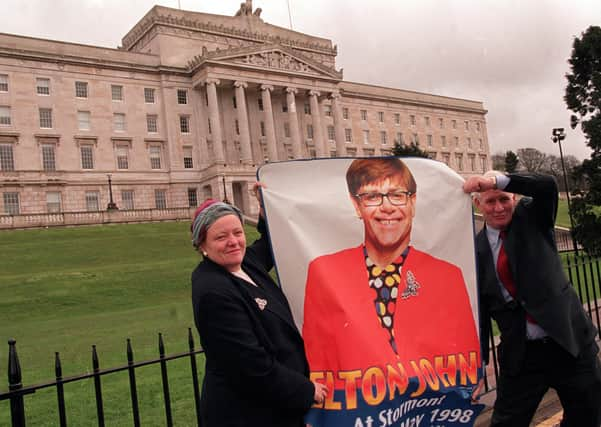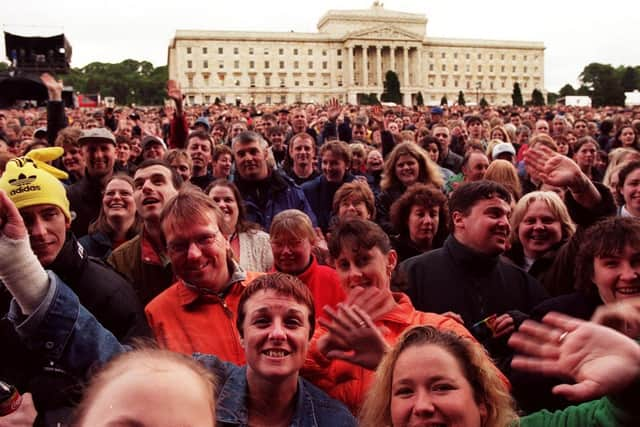Government pondered renaming or giving away Stormont as it meticulously planned for the Good Friday Agreement, declassified files reveal


One 1997 file released at the Public Record Office in Belfast runs to more than 1,000 pages and deals solely with a strategic plan to open up the Stormont Estate to the public – but especially to Catholics and young people.
While that was known at the time, the documents reveal not only that new Prime Minister Tony Blair was heavily involved in the plan, but that it was given an exceptionally high priority – and went ahead despite a blunt RUC warning.
Advertisement
Hide AdAdvertisement
Hide AdIn a December 1997 letter to Mr Blair, Secretary of State Mo Mowlam said: “When I told you recently about our efforts to attract a wide range of events to Northern Ireland, I mentioned that we have initiated an exercise to explore how we might, over time, change the image of Stormont, starting with measures to make Parliament Buildings and the Stormont Parklands more accessible.”


She said that in Parliament Buildings this would involve “controlled access to public areas by tourists and schoolchildren”, functions for visiting VIPs, charities, and public bodies, a “carefully-designed permanent historical exhibition”, regular public exhibitions, and “mainly classical musical events”.
In the Stormont Estate, she said there would be classical and popular musical events “including, following your approach to his manager, an Elton John concert in July 1998”, outdoor events such as a garden party for young people, developing the parklands with a play area, jogging tracks and nature walks, and “holding special events, including use of the playing fields as a venue for some of Ireland’s international cricket matches”.
She said that security had to be retained and that “I need to take the local politicians along with us in these measures. Nationalists will likely be sceptical and unionists will be concerned about devaluing the standing of Stormont”.
Advertisement
Hide AdAdvertisement
Hide AdHowever, a draft of that memo includes several lines which were more explicit about what the NIO was attempting to do. In the draft, Dr Mowlam said that as the former seat of the old Northern Ireland Parliament, Stormont was “perceived by many nationalists as a symbol of unionist domination” and “for the last three decades it has been encased in tight security”.
She added: “The building stands ready physically to be the centre of a devolved administration, but its ethos would not, at present, help to underpin the spirit of a new regional body.”
Eight days later, Mr Blair’s private secretary John Holmes said in reply: “The Prime Minister has seen Dr Mowlam’s minute...He thinks these ideas are excellent and warmly endorses them. As you know, he remains very keen to see a series of major public events in Northern Ireland as the peace process moves on, to help give the people of Northern Ireland the feeling that something new and exciting is happening of which they are part.”
Three months earlier, in another memo to the prime minister on the same topic, Dr Mowlam said that there had been “some tentative discussions about the possible relocation of a Premier League football team to Belfast”.
Advertisement
Hide AdAdvertisement
Hide AdThat issue was also raised with the editors of the three Belfast daily newspapers by NIO minister Lord Dubs.
Although the plan to see Wimbledon move to Belfast fell through, it is one of multiple areas where the new Labour administration was prepared to endorse radical ideas in attempting to create an atmosphere more conducive to its strategic goal of a seminal political settlement.
At that time Dr Mowlam told the prime minister that bringing major entertainment events to Northern Ireland would “assist in creating a positive, vibrant mood; help in building greater community self-confidence and self-esteem; bring the different parts of the community together; enable the area to present a more attractive image to the rest of the world; and thus help to create a better atmosphere in which to seek a sustainable political settlement”.
She told Mr Blair that the Northern Ireland Events company – which would later fall apart in scandal – had been established to encourage major events to be held in the Province and added that a personal approach by him to Elton John could help secure the star for a Stormont event, something which Mr Blair did, and led to the singer-songwriter playing a memorable concert there in front of 15,000 people the following year.
Advertisement
Hide AdAdvertisement
Hide AdA December 1997 memo from Dr Mowlam’s private secretary said that “Peter Robinson’s reaction when asked about concerts at Stormont was not negative, in fact he offered to take soundings himself”.
The same memo said that “the Secretary of State agreed that a classical concert, RUC tattoo, Garth Brooks or the like would be very acceptable at Stormont”.
The changed atmosphere also extended inside Parliament Buildings. In August 1997 Doreen Brown in the central secretariat said that the head of the civil service, Sir David Fell, “is keen that we should aim to make the surroundings in Parliament Buildings as neutral as possible, avoiding giving the impression that it was a ‘unionist’ building.
“That would mean that the various artefacts which in the past were distributed round various parts of the building should not be on display when the building is reopened. What we have in mind are artefacts such as swords, trophies, tunics, etc.”
Advertisement
Hide AdAdvertisement
Hide AdAn August 1997 memo from DoE permanent secretary Ronnie Spence to Dr Mowlam shows that even changing the name of Parliament Buildings was discussed. He said: “The forthcoming reoccupation of Parliament Buildings provides an opportunity to reconsider its name.
“The word ‘Stormont’ is frequently used to describe the building but the present, correct address is Parliament Buildings. There is, however, unlikely ever to be a ‘parliament’ in the building again.
“Suitable alternative names are not, however, easy to find. There is a risk of continued confusion with Stormont Castle and Stormont House. There is already an ‘Assembly Buildings’ in Belfast. ‘Government Offices, Stormont’ is too bland.
“Dublin still has buildings named after the Irish Parliament which disappeared at the start of the 19th century. Any change of name could attract criticism, especially from unionists.”
Advertisement
Hide AdAdvertisement
Hide AdHe concluded: “On balance, it seems best to continue with the present name and to leave any new Northern Ireland Assembly to agree any name change.”
Officials considered transferring the Stormont Estate to the National Trust as part of their efforts to turn around its image.
However, it was pointed out to them that The Stormont Estate and Government Property Act (NI) 1933 debarred the government from “selling, exchanging, leasing or surrendering the land building and premises at Stormont as set out in an indenture between Arthur Charles Stewart Cleland (and others) and the Commissioners of His Majesty’s Works and Public Buildings.”
The file also shows that RUC Assistant Chief Constable Tim Lewis told the NIO bluntly: “Some ideas which are being advanced in this re-imaging project frankly defy reason and if implemented would effectively side-line security in the estate and expose a number of buildings and personalities to much greater risk of attack.”
Advertisement
Hide AdAdvertisement
Hide AdHe said that the suggestion to pull back the perimeter security to a point behind Carson’s Statue would be “an open invitation to all groupings of ill-intent to assess means of attacking virtually all the buildings on the estate”.
MORE FROM THE DECLASSIFEID FILES:
Advertisement
Hide AdAdvertisement
Hide Ad——— ———
A message from the Editor:
Thank you for reading this story on our website. While I have your attention, I also have an important request to make of you.
With the coronavirus lockdown having a major impact on many of our advertisers — and consequently the revenue we receive — we are more reliant than ever on you taking out a digital subscription.
Subscribe to newsletter.co.uk and enjoy unlimited access to the best Northern Ireland and UK news and information online and on our app. With a digital subscription, you can read more than 5 articles, see fewer ads, enjoy faster load times, and get access to exclusive newsletters and content. Visit https://www.newsletter.co.uk/subscriptions now to sign up.
Advertisement
Hide AdAdvertisement
Hide AdOur journalism costs money and we rely on advertising, print and digital revenues to help to support them. By supporting us, we are able to support you in providing trusted, fact-checked content for this website.
Alistair Bushe
Editor